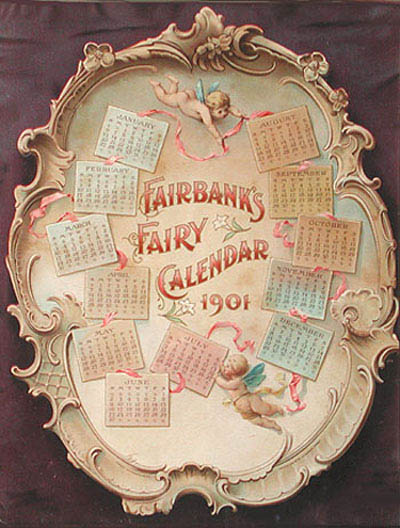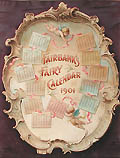| Tilte: |
Fairbank's Fairy Calendar 1901 |
| Printer: |
American Lithographic Co., N. Y. (ALCO) |
| Advertiser: |
Fairbanks Fairy Soap Company |
| Date: |
1900 |
| Medium: |
Original Chromolithograph |
| Note: |
Fairbanks Fairy Soap Company: Of all the art produced by companies during the turn of the century
the Fairbank's Company is one of the most sought after. Their
popular Fairy Soap product was promoted by visual images dealing with
fairy customs and habits. Recognizing the importance of the advertisements,
Fairbank's produced lavish chromolithographs, including annual calendars.
Fairbank's Fairy Calendar: 1901 depicts fairies arranging the months of
the year within an elaborate soap dish which makes for a very convenient
visual frame. |
| |
Nathaniel Kellogg (New York, 1829-Chicago, 1903): In 1875, Nathaniel Kellogg founded the N. K. Fairbank Co.,
a manufacturing company of cleansing and baking products. Procter & Gamble purchased Fairy brand from Kellogg.
The Fairy brand appears on a variety of household cleaning products to this day. In 1899, the Women's suffrage leader,
Elizabeth Cady Stanton endorsed Fairbanks' Fairy Soap in a series of adds and was quoted as saying, "I find it delightful...".
|
| |
Sarony and Major, Sarony & Company: Born
of English parents in Quebec City, Napoleon Sarony (Quebec, 1821 - New York, 1896) learned lithography from his father and emigrated to New York in 1836.
There, he worked as an apprentice for several lithographers, including Nathaniel Currier.
Sarony then opened a lithographic business in partnership with Henry B. Major. The company went through a number of confusing overlapping alterations in names and partnerships.
It was called 'Sarony and Major' (c. 1846 - 1857). Then Sarony's company bore the title, 'Sarony & Company'
(c. 1853-1857). |
| |
Sarony, Major & Knapp, The Knapp Company, and the Joseph P. Knapp Co.: During the mid
1850's, Joseph Fairchild Knapp (1832-1891), entered the firm and the name of the company was expanded to, 'Sarony, Major & Knapp' (c 1855 - c. 1864),
and during this period produced many scientific and historical works of art as well as art dealing with other genres. Napoleon Sarony left the partnership around 1864
to pursue a new career in photography. Students of early photography will at once recognize his name as he rose to become
one of America's most famous pioneers in this field. After Sarony's departure, the company took on the name of, Major & Knapp around 1864, and by 1888 it became known as The Knapp Company. Around 1890, Joseph Palmer Knapp (1864-1951),
purchased the company from his father and shortly after renamed it, the 'Joseph P. Knapp Co.'. Later, the company would assume the title of the 'American Lithographic Company',
and from 1892 to 1929, it became one of the largest lithographic firms in North America. |
| |
The American Lithographic (ALCO) 1892-1929:
In 1892, the financial Commercial Chronicle and Hunt's Merchants' Magazine,
a weekly Newspaper reported the consolidation of business interests under
the title of the "American Lithographic Co.," purchased by
the Knapp Company, New York. The firms that were integrated into this merger were
all competing for the cigar label and advertising industry at the time.
This merger included, George S. Harris & Sons, Philadelphia, Harris
founded the cigar label lithographic company in 1847; Heppenheimer's
and Sons, one of the nation's most important cigar label printers (1851-1892)
founded by Frederick Heppenheimer, the Donaldson Brothers Co., NY, the Giles
Company, Eddy & Calaus, Witsch & Schmitt, and Schumacher & Ettinger.
The President of the new company would become Mr. P. Knapp. The American
Lithographic Company printed and published everything from
advertising art to fine art prints such as, cigar labels, trade cards,
world war one posters and works of art dealing with many other subjects.
This Fairbank's Fairy calendar from 1901 is a fine examle of the
chromolithographic art created by ALCO during this period.
Around 1928, the firm was purchased by the United States Printing & Lithographic Company.
In 1929, the Consolidated Litho Company took over their label producing division. |
| |
When Joseph P. Knapp’s company became
the art publishing branch of the 'American Lithographic Company' (ALCO), they continued producing great works of art under various Knapp names. The Knapp
firms were the advertising specialty printers of calendars and promotional items until 1929 when the firms were sold. |
| Note: |
Chromolithography -- printing images in color by using a series
of carefully registered tint stones -- became the most popular method
for the original printmaking of everything from trade cards to fine art
during the last half of the nineteenth century. The far less costly advancements
of photomechanical methods, however, made this original and complex form
of graphic art all but obsolete by the 1930's. |
| |
Firms were quick to recognize the vast potential of the chromolithographic
technique. Beginning in 1870, advertisers regularly allied their products
to appealing visual imagery. By 1890 companies were creating the most
expensive and elaborate works, spending thousands of dollars on additional
methods such as raised printings, bronzing and multiple hues. As antique
art forms, advertisements, more than any other works, reflect the true
tastes of the times. |
| |
A true chromolithograph -- such as this example -- is easily distinguishable
by its deep, bright, oil based colors. They are becoming increasingly
scarce and the buyer should therefore be aware of modern, photographically
based reproductions which are surfacing in both antique shops and art
galleries. |
| Size: |
11 1/2 X 9 (Sizes in inches are approximate,
height preceding width of plate-mark or image.) |
| |
Matted with 100% Archival Materials |
| |
View larger Matted Image |
| |
 |
| Condition: |
Printed on wove paper and with full margins as published for the Fairbank's
Company by the American Lithographic of New York (ALCO), in 1900. Several slight crease marks exist around the corners
but in no way affect the central image. It is in very good condition throughout
without a sign of time staining or fading. |
| Price: |
Sold - The price is no longer available. |
| Important Information: |
The artist biographies, research and or information pertaining to all the original works of art posted on our pages has been written and designed by Greg & Connie Peters exclusively for our site, (www.artoftheprint.com). Please visit us regularly to view the latest artworks offered for sale. We will soon be posting an update of our most recent research and include the biographical and historical information pertaining to our next collection of original works of art created by artists throughout the centuries. We hope you found the information you were looking for and that it has been beneficial.
Our Gallery, (Art of the Print / www.artoftheprint.com) guarantees the authenticity of every work of art we sell 100%. Full documentation and certification is provided. We offer a wide selection of international fine art dating from the early Renaissance to the contemporary art period. |





![]()
![]() or
phone Greg & Connie (905) 957-6666
or
phone Greg & Connie (905) 957-6666